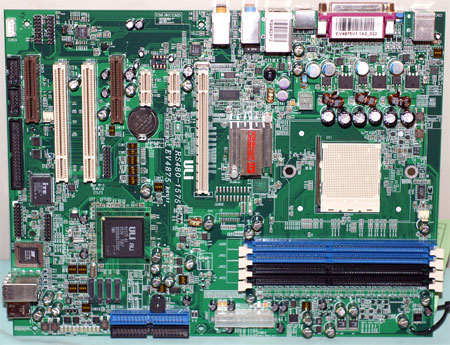
Original Link: https://www.anandtech.com/show/1819
ULi M1575 for ATI Crossfire – SATA2 and Fast USB for the ATI Chipset
by Wesley Fink on October 13, 2005 4:21 PM EST- Posted in
- CPUs
We were extremely impressed with the performance of the new ATI Radeon Xpress 200 for AMD in Crossfire dual video versions in ATI's Crossfire: Best Overclocker on the Market? and single video versions in Sapphire PURE Innovation - ATI's Chipset for the AMD Enthusiast. The Reference Boards showed the Xpress 200 for AMD to be a top-notch chipset aimed at the enthusiast with performance to match. However, we found an Achilles heel in our initial testing; namely, sub-par UBS 2.0 performance on the ATI SB450 South Bridge and the lack of up-to-date storage features like support for SATA2 and NCQ.
The ULi M1573 South Bridge could be used with the ATI North Bridge to add NCQ and improved USB performance, but the truly competitive South Bridge would not happen until SB600 from ATI early next year or the updated ULi M1575.
ULi apparently saw the potential and we have in our hands today an M1575 Reference Board that claims fully competitive USB 2.0 performance and full SATA2 support with NCQ. We never expected that AnandTech would be reviewing South Bridges, but we will go wherever we need to provide you with the best information and most up-to-date choices available. The South Bridge concerns also become more important as we have confirmation that we will receive ATI Crossfire AMD boards from DFI, ECS, and Asus in the next 10 days.
ULi supplied the M1575 in a single PCIe slot configuration with an ATI RS480 North Bridge and a ULi M1575 South Bridge. The Reference Board was clearly designed for qualification of the M1575 South Bridge only. It does not offer memory timings, voltages, ratios, or any other features in BIOS to truly asses overclocking capabilities. While there are switch blocks on the Reference board with wide voltage adjustments for all the key components, there were no CPU ratio adjustments. For these reasons, our benchmarking will only test the features of the M1575. For additional Information on the performance and overclocking capabilities of the ATI North Bridge, refer to the Crossfire AMD launch article.
Features: ATI RS480/ULi M1575 Reference Board
The ULi M1575 Reference Board combined an ATI RS480 North Bridge with the ULi M1575 South Bridge to demonstrate clearly full compatibility with the ATI North Bridge. It is worth pointing out that the ATI RS480 supplies 22 PCIe lanes. The M1575 adds 4 more PCIe lanes. That means that the RS480/M1575 combo provides a total of 26 PCIe lanes compared to the total 20 lanes in competitors’ single-chip solutions.
| ULi RS480/M1575 Reference | ||
| Processor | Socket 939 for AMD K8 Processor | |
| Chipset | ATI RS480 + ULi M1575 RS480: ● Supports HyperTransport Bus 16×16 @ 1000 MHz Double Data Rate with LVDS-like differential technology (transfer rate 8 GB/S Max.). ● Supports three PCI-Express 22 lanes. M1575 : ● Supports PCI-Express 4 lanes. |
|
| Memory | ● Provides 4 184-pin DIMMs for PC1600/2100/2700/3200 DDR SDRAM up to 4GB. ● Supports up four unbuffered DDR DIMMs modules per the DDR SDRAM with a maximum capacity of 1 GB per module. ● Up to four unbuffered DIMMs in a 128-bit configuration, or up to two unbuffered DIMMs in a 64-bit configuration. |
|
| Expansion Slots |
● 1 PCI-E_X16 slot ● 2 PCI-E_X1 slots ● 2 PCI slots ● 1 CNR slot ● 1 LPC slot |
|
| Onboard Audio/LAN | ● Built-in 7.1-channel AZALIA CODEC (Realtek ALC880) ● Built-in 10/100 Ethernet PHY onboard (DAVICOM DN9161) |
|
| Standard I/O |
● Provides 6 audio jacks (Mic In, Line In, Line Out, Surround, Surrback, Cen/Lfe), 1 Analog Line-IN header (CD_IN). ● Provides 1 RJ-45 connector for LAN. ● PS2 Keyboard, PS2 Mouse, 1x FDD, 2xCOM, 1xLPT onboard ● 8 Universal Serial Bus (USB 2.0) ● 2 Ultra DMA 33/66/100/133 IDE Connectors ● 4 Serial ATA Connectors |
|
| System BIOS |
● LPC ROM (4Mb and architected by Super I/O) (ITE8712F_IX) ● ACPI 2.0, DMI 2.0, APM 1.2, WFM 2.0, SMBIOS 2.3, Sm art for HDD, PnP 1.0a, USB 2.0/1.1, PCI 2.2 ● Supports S0, S1, S3, S4 and S5. ● Supports AMD Power-Now. ● Supports en/disable C2 and C3 Function. ● Stepless frequency selection and over system bus frequency (over CLK operation Option) (ICS 951416) ● CPU/System FAN revolving detection ● CPU/System Temperature detection ● System Voltage detection ● USB device wake-up from S1, S3, S4 (Optional) ● KB/Mouse wake-up from S1-S3 ● Wake-on-LAN from S1, S3-S4 ● Wake-on-Ring from S1, S3-S4 |
|
| System Protection and Management |
● Hardware monitoring (ITE8712F_IX) ● CPU Thermal Protection ● 2 Fan (1 CPU Fan, 1 SYS Fan) connectors |
|
The ULi M1575 South Bridge
The earlier ULi M1573 South Bridge had a feature set roughly comparable to the ATI SB450 South Bridge described in the Crossfire AMD launch article. The only real difference is that M1573 does support NCQ on hard drives while the ATI RS450 does not. M1575 updates M1573 for a much more competitive feature set.
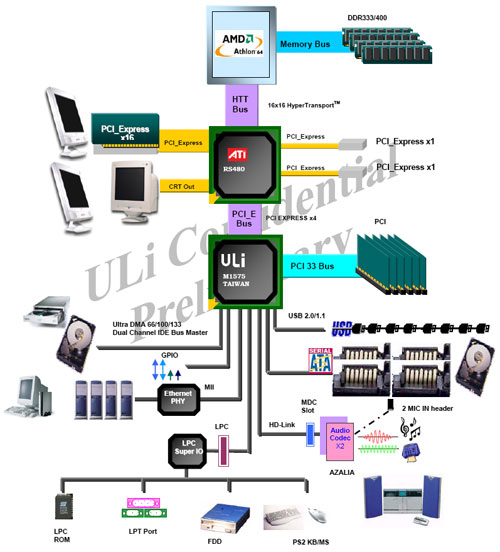
- 4-Drive Serial ATA II 3Gb/s (AHCI) with NCQ Support
- RAID 1, 0, 0+1, 5, JBOD
- PCI Express Interface to North Bridge (Like SB450 and M1575)
- High Definition Audio and AC'97 Audio
- Full ACPI and Legacy Interrupt/DMA support
The M1575 feature set is very competitive except for the fact that it only supports 10/100 Ethernet. However, PCIe Gigabit Ethernet can be added to PCIe lanes on the South Bridge or North Bridge to provide a dual Gigabit PCIe/10-100 PCI LAN solution.
Disk Controller Performance
With so many chipsets and brands of storage controllers on current Athlon 64 boards, we standardized on Anand’s storage benchmark, first described in Q2 2004 Desktop Hard Drive Comparison: WD Raptor vs the World, as a standard means of measuring disk controller performance. To refresh your memory, the iPeak test was designed to measure "pure" hard disk performance, and in this case we kept the hard drive as consistent as possible while varying the hard drive controller. The idea is to measure the performance of a hard drive controller with a consistent hard drive. We played back Anand’s raw files that recorded I/O operations when running a real world benchmark - the entire Winstone 2004 suite. Intel's IPEAK utility was then used to play back the trace of all the IO operations that take place during a single run of Business Winstone 2004 and MCC Winstone 2004. To try to isolate performance difference to the controllers we were testing, we used Seagate 7200.7 model SATA and IDE hard drives for all tests.
iPeak gives a mean service time in milliseconds; in other words, the average time that each drive took to fulfill each IO operation. In order to make the data more understandable, we report the scores as an average number of IO operations per second so that higher scores translate into better performance. This number should not be used to report hard disk performance as it is just the number of IO operations completed in a second. However, the scores are useful for comparing “pure” performance of the storage controllers in this case.
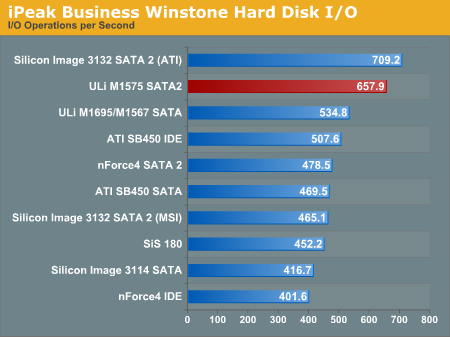

In past benchmarking, IDE has provided the slowest IO performance in this roundup. However, ULi and ATI IDE break that trend, with IDE performance being the best that we have measured since we have been testing with iPeak.
There are no additional SATA/SATA2 controllers on the ULi M1575 Reference Board, but with excellent IDE and SATA2 disk performance, there is really no need for additional discrete controllers unless you need more than four SATA2 drives.
USB, Firewire & Storage Performance
After looking at many options for Firewire and USB testing, we finally determined that an external USB 2.0, Firewire 400, and Firewire 800 hard disk might be a sensible way to look at USB and Firewire throughput.
Our first efforts at testing with an IDE or SATA drive as the “server” yielded very inconsistent results, since Windows XP sets up cache schemes to improve performance. Finally, we decided to set try a RAM disk as our “server”, since memory removed almost all overhead from the serving end. We also managed to turn off disk caching on the USB and Firewire side by setting up the drives for “quick disconnect” and our results were then consistent over many test runs.
We used just 1GB of fast 2-2-2 system memory set up as a 450MB RAM disk and 550MB of system memory. Our stock file was the SPECviewPerf install file, which is 432,533,504 bytes (412.4961MB). After copying this file to our RAM disk, we measured the time for writing from the RAM disk to our external USB 2.0 or Firewire 400 or Firewire 800 drive using a Windows timing program written for AnandTech by our own Jason Clark. The copy times in seconds were then converted into Megabits per second (Mb) to provide a convenient means of comparing throughput. Higher rates therefore mean better performance.
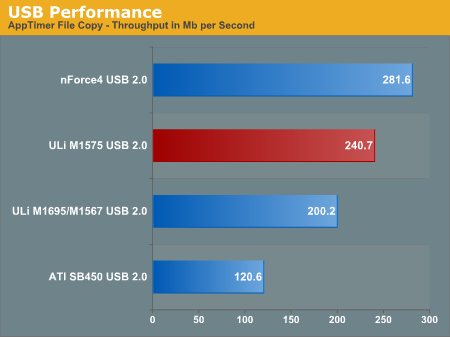
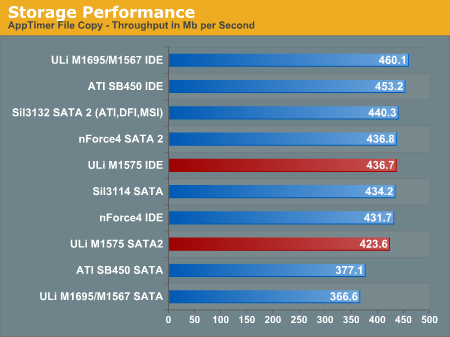
Audio Performance
For audio testing, we use Rightmark 3D Sound CPU utilization test. This benchmark measures the overhead or CPU utilization required by a codec or hardware audio chip.
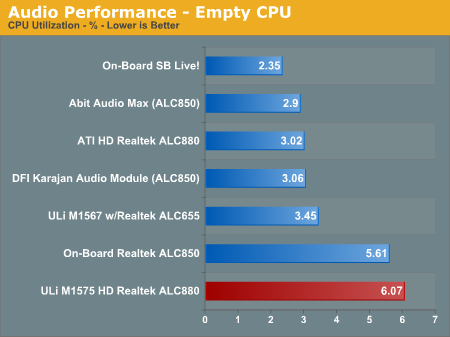
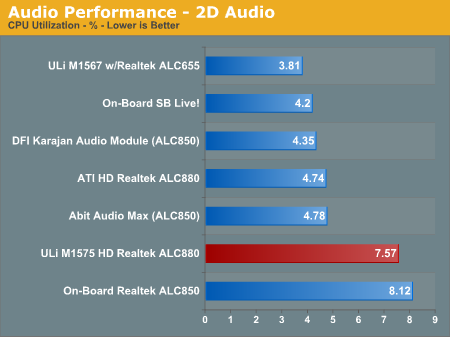
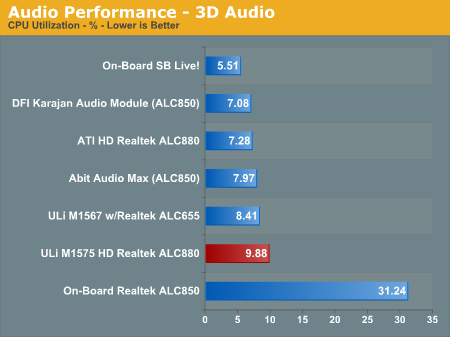
However, we know that this audio solution is particularly sensitive to the drivers used. Since ULi is trailing the AT HD performance on the same codec, it appears ULi needs to work to improve the drivers to lower CPU utilization. With revised drivers, it is reasonable to expect the ULi M1575 to perform about the same as the excellent performance of the ATI SB450.
Final Words
With the introduction of the ULi M1575 South Bridge, the last issues with the ATI chipset are finally cleared up. The M1575 fixes the sub-par USB 2.0 performance of the ATI SB450 and it brings the missing SATA2 and NCQ performance to the ATI Crossfire and Xpress 200. When combined with the ATI Rx480/482 North Bridge, the ULi M1575 delivers a competitive set of features that will not be available with an ATI South Bridge until the SB600 in early 2006.
The only missing ingredient for the ULi M1575 is built-in support for Gigabit LAN, as the chipset only directly supports 10/100 Ethernet. Of course this compares to the ATI SB450, which offers no on-chipset LAN at all. Our advice for both South Bridges is to make sure you are getting a board with a PCIe implementation of Gigabit LAN, as the PCI version will limit bandwidth of Gigabit Ethernet.
We have learned that many of the delays that we are experiencing in retail delivery of the ATI chipset motherboards - both Crossfire and single-video - are because many manufacturers made the last-minute decision to use the ULi M1575 South Bridge. Development and delivery of the M1575 has taken longer than ULi originally expected, but M1575 chips are finally on their way to manufacturers.
The reality of the M1575 only makes the wait for retail AMD Crossfire motherboards even more frustrating, but it finally appears that the wait is only a few more days. DFI tells us that their first retail ATI Enthusiast Crossfire boards will appear at E-tailers, like New Egg, sometime next week. DFI also plans a second version of an enthusiast ATI board that will appear 2 to 3 weeks after the first Crossfire AMD version. MSI, Gigabyte and ECS will have boards available by the end of October. MSI will use both ULi M1575 and ATI SB450 on their ATI chipset boards, depending on the target audience.
Asus now confirms that they are committed to a Crossfire AMD, in addition to the announced Crossfire Intel, that will appear by the end of October. Asus made the decision to use the ULi M1575 chipset tested here, and delays have been caused by the qualification and delayed shipments of the M1575 South Bridge. We also learned that Abit will begin selling an enthusiast-geared Crossfire AMD that is scheduled to appear sometime in early November.
The ULi M1575, when combined with the ATI Rx480/482 Northbridge, makes the chipset a much more attractive offering in the current market. Those who are concerned about USB performance or SATA2 and NCQ will now be able to choose ATI chipset boards that use the ULi M1575 South Bridge. If these are not critical features in your choice, you can still choose a board with the SB450 South Bridge. Both feature excellent Azalia HD audio - the first chipsets to feature HD audio for the AMD processor. Both also feature excellent IDE and SATA performance.
Choice is good - in South Bridges, chipsets, and boards. Choice means competition and competition means better value. The AMD and Intel motherboard markets are about to get a lot more interesting.

